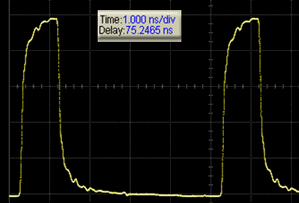 Short Optical Pulses as Lab Tools
Short Optical Pulses as Lab Tools
February 21, 2017
A previous article on our blog noted how short electrical pulses are useful laboratory tools; however, pulses are also very important in many optical applications. One method to generate short pulses is to employ a mode-locked laser. These lasers usually have very wide optical bandwidths (< 1 ps pulse widths), but typically the repetition rate is fixed and the wavelength is seldom tunable. By combining a NuCrypt pulse-picker with a tunable optical filter, the repetition rate can be down-counted by a programmable integer and the central wavelength can be tuned to a desired wavelength. The resulting pulse width is inversely proportional to the filter bandwidth, and is about 4 ps for a 1 nm filter centered at 1550 nm. Alternatively, NuCrypt offers an optical pulse generator that directly carves pulses from a CW source, including the option of using a widely tunable seed laser. This gives much more flexibility in terms of programming the pulse width and repetition rate, but unlike mode locked lasers the minimum pulse width is ~100 ps (2 ns maximum pulse width).
Generating pulses can greatly ease the power burden normally required to produce nonlinear optical effects. This is because many nonlinear optical effects rely on peak power levels, but typical Erbium doped fiber amplifiers (EDFAs) are average-power limited. By carving optical pulses with a duty cycle of 100:1 (e.g. 100 ps pulses at a 10 MHz rate), a common inexpensive EDFA with >20 dB gain and >10 mW of output power can generate >1 W of peak power. This effect is useful, for instance, to maximize the conversion efficiency of nonlinear frequency converters like periodically poled Lithium Niobate second harmonic generators. If the crystal has a small signal conversion efficiency of 10%/W, then a 10 mW CW signal will only generate 10 mW of harmonic power. However, a 10 mW pulsed signal with a 100:1 duty cycle would generate 1 mW of harmonic power. Not only is the nonlinear effect greatly enhanced, but the average powers are still kept low which can reduce the impact of optical damage or optical heating.
By leveraging pulses, reaching powers high enough to exploit nonlinear optical effects does not have to come at great expense or risk. Additionally, pulses can be used for a wide range of other applications, such as to measure linear effects like chromatic dispersion in optical fiber, making optical pulse generation and control an essential laboratory tool.
Are you interested in this type of cutting-edge technology for your lab? We can help.
NuCrypt offers a variety of customizable instrument solutions for our customers' unique needs. Contact us at (224) 361-3028 for more information.
